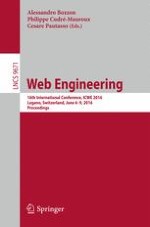This book constitutes the refereed proceedings of the 16th International Conference on Web Engineering, ICWE 2016, held in Lugano, Switzerland, in June 2016.
The 19 full research papers, 13 short papers, 3 vision papers, 11 demonstrations, 5 posters, 6 PhD Symposium and 4 tutorials presented were carefully reviewed and selected from 120 submissions.
The 16th edition of ICWE accepted contributions related to different research areas revolving around Web engineering, including: Web application modelling and engineering, Human computation and crowdsourcing, Web applications composition and mashups, SocialWeb applications, SemanticWeb, and, for the first time, also the Web of Things.
